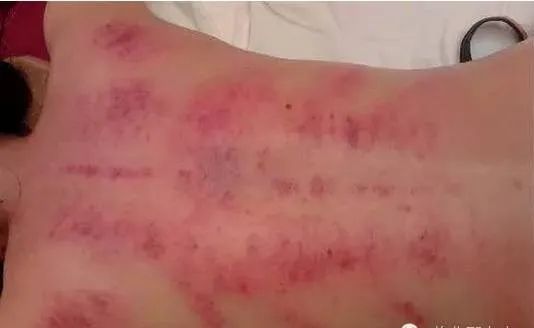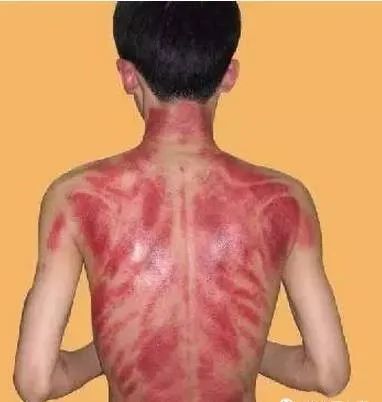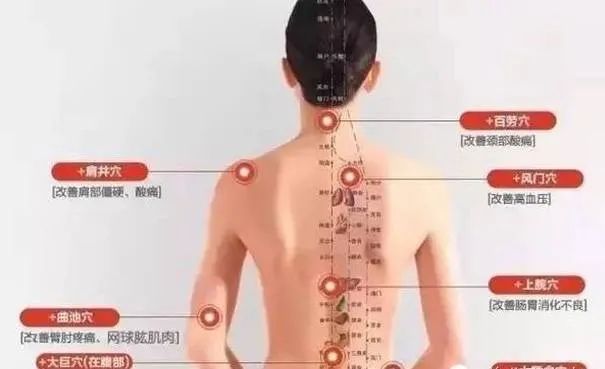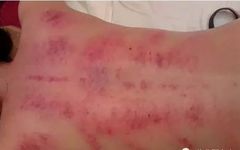Principle of Gua Sha
Gua Sha is based on the twelve meridians and eight extraordinary vessels of Traditional Chinese Medicine (TCM), following the principle of treating the symptoms when they are acute. It involves strong stimulation of the meridians using hand techniques to cause local skin redness and congestion, thereby achieving effects such as awakening the spirit, relieving heat, detoxifying, promoting qi circulation, alleviating pain, and strengthening the spleen and stomach.
Areas for Gua Sha
Many areas of the body can be treated with Gua Sha, commonly including the area around the seventh cervical vertebra, both sides of the throat, the bends of the arms and legs, both sides of the spine, intercostal spaces in the front and back, the Achilles tendon behind the inner and outer ankles, the liver and spleen areas below the ribs, and above and below the shoulder blades. For back Gua Sha, the patient should lie face down, while for shoulder Gua Sha, the patient should sit upright. After scraping, purple bruising may appear.
The most commonly scraped area is the shoulder and neck, which can help reduce fever, dispel heat, and eliminate wind-cold, known as the “Three Lines of the Neck.”This area is located at the junction of the head and neck; if it is tense, it can cause obstruction of qi flow throughout the body, preventing heat from dissipating.
How to Perform Gua Sha Correctly?
1. Gua Sha Tools
The tools for Gua Sha are often specially made scraping boards made from water buffalo horn, typically rectangular with rounded edges.
2. Indications for Gua Sha
Common conditions treated include colds, fevers, heat stroke, headaches, gastrointestinal disorders, stiff neck, shoulder periarthritis, lumbar muscle strain, muscle spasms, and rheumatoid arthritis.
3. The Gua Sha Process
First, clean the area to be scraped. Dip the edge of the scraping board in Gua Sha oil or massage oil, and then perform Gua Sha on the designated area. Scrape in one direction only, avoiding back-and-forth motions, applying even and appropriate pressure. If there are sha symptoms, scrape the bends of both arms several times until dark purple streaks appear. Generally, scrape each area about 20 times.

If experiencing headaches or throat pain, sit; if feeling dizzy or having chest or abdominal pain, lie on your back; if there is pain in the shoulders, back, or lower back, lie face down.
Generally, follow the previously mentioned scraping areas. If completed in sequence, the patient will feel immediate relief. Allow the patient to rest for a few minutes, then scrape the front chest, back intercostal spaces, above and below the cervical vertebrae, and each shoulder blade area for about ten more times. Drinking ginger sugar water or plain water afterward will enhance comfort.
Precautions for Gua Sha
1. Ensure the room is warm during Gua Sha treatment, especially in winter, to avoid cold drafts. In summer, avoid direct airflow from fans on the scraped area.
2. Avoid taking a cold shower within 30 minutes after Gua Sha.
3. Do not scrape the same area again until the previous sha marks have faded, which usually takes 3-6 days.
4. It is best to drink a cup of warm water (preferably lightly salted sugar water) after Gua Sha and rest for 15-20 minutes.
What is “Sha”?
When pressure is applied with the Gua Sha board, blood that has accumulated due to microcirculation obstruction seeps out from the capillaries and remains between the skin and muscle, which is what we see as “sha.”
In TCM, “sha” is considered a type of stasis, indicating an imbalance within the body. Stasis implies blockage; when the body is obstructed, qi and blood cannot flow smoothly, leading to pain and various symptoms.
Modern science has proven that Gua Sha can dilate capillaries, increase sweat gland secretion, and promote blood circulation, providing immediate effects for conditions such as hypertension, heat stroke, and muscle soreness.
Regular Gua Sha can help regulate qi, relieve fatigue, and enhance immune function.
Why Perform Gua Sha?
The effects of Gua Sha on the skin can be broadly categorized into two types: preventive health care and therapeutic effects.
1. Preventive Health Care
Preventive health care includes both health maintenance and disease prevention. The areas treated by Gua Sha are the skin, which is the body’s most superficial layer exposed to the external environment and plays a role in adapting to and defending against changes in climate.
The skin’s ability to perform these functions relies on the body’s defensive qi. Defensive qi originates from the upper jiao, propelled by lung qi, circulating through the skin. When defensive qi is balanced, “the skin is soft, and the pores are dense” (from the “Lingshu, On the Organs”).
Healthy individuals who regularly undergo Gua Sha (such as at the back shu points or Zusanli point) can enhance their defensive qi. A strong defensive qi improves the body’s ability to resist external pathogens, thus maintaining health. If external pathogens invade, causing symptoms like chills, fever, nasal congestion, or runny nose, timely Gua Sha (such as at the Feishu or Zhongfu points) can help expel these pathogens to prevent them from spreading into the internal organs and causing serious illness.

2. Therapeutic Effects
The therapeutic effects of Gua Sha can be observed in the following aspects:
1. Activating Blood and Dispelling Stasis
Gua Sha can regulate muscle contraction and relaxation, adjusting interstitial pressure to promote blood circulation around the scraped tissues. This increases tissue perfusion, achieving the effects of “activating blood and dispelling stasis” and “removing stasis to generate new blood.”
2. Balancing Yin and Yang
Gua Sha has a significant effect on adjusting the balance of internal organ functions. For example, in cases of hyperactive intestinal peristalsis, applying Gua Sha techniques to the abdomen and back can suppress the hyperactivity and restore normal function. Conversely, for those with reduced intestinal motility, Gua Sha can promote its recovery. This indicates that Gua Sha can improve and balance the functions of the internal organs.
3. Relaxing Muscles and Unblocking Meridians
Soft tissues such as muscle attachment points, fascia, ligaments, and joint capsules can send pain signals through reflex actions of the nerves, causing the related tissues to be in a state of alert. Muscle contraction, tension, and even spasms are reflections of this alert state, aimed at reducing limb movement to alleviate pain, which is a natural protective response of the body.

If not treated promptly or thoroughly, damaged tissues can form varying degrees of adhesions, fibrosis, or scarring, leading to continuous harmful impulses, exacerbating pain, tenderness, and muscle tension, which can create secondary pain foci in surrounding tissues, resulting in metabolic disorders and further aggravating the pathological changes of “no flow equals pain.”
Clinical experience shows that wherever there is pain, there must be muscle tension; wherever there is muscle tension, there will inevitably be pain.
These conditions often have a causal relationship. In Gua Sha treatment, we observe that eliminating the pain focus also alleviates muscle tension; if tense muscles are relaxed, pain and pressure symptoms can significantly reduce or disappear, facilitating the healing of the pain focus.
Gua Sha is an effective method for relieving pain and muscle tension and spasms, with the following main mechanisms:
1. Enhancing Local Circulation and Increasing Local Tissue Temperature.
2. Under the direct stimulation of various techniques using the Gua Sha board, the pain threshold of local tissues is raised.
3. The relationship between tense or spasmodic meridians and the twelve skin areas: “To understand the skin areas, one must refer to the meridians; all meridians are like this.”
The division of the twelve skin areas is based on the distribution of the twelve meridians, each of which has branches that float on the surface of the body, each with its own distribution area. Since there are twelve meridians, the skin areas are also divided into twelve, with the six meridians of the hands and feet corresponding to the six skin areas.
The branches of the meridians are called collaterals, and the skin areas can be considered subdivisions of these collaterals. Thus, the “Su Wen, On the Skin” states: “All twelve meridians are parts of the skin.” The relationship between the meridians and the skin areas is significant for diagnosing and treating diseases.
The “Su Wen, On the Skin” states: “The skin is the part of the meridian; if pathogens invade the skin, the pores open, allowing the pathogens to enter the collaterals, filling the collaterals and then entering the meridians, and when the meridians are full, they affect the organs.” This indicates that pathogens enter from the outside, and through the use of the Gua Sha board and various techniques, the muscles can be relaxed, alleviating tension and spasms to eliminate pain.
4. Information Adjustment
Each organ in the body has its specific biological information (inherent frequencies and bioelectricity). When an organ undergoes pathological changes, its biological information changes, affecting the functional balance of the entire system.
By applying various stimuli or forms of energy to specific areas of the body, certain biological information is generated and transmitted to the relevant organs, adjusting the abnormal biological information, thus affecting the pathological organs. This is one of the bases for Gua Sha’s therapeutic and health-promoting effects.
For example, using scraping, point stimulation, or pressing techniques on the Neiguan point can adjust coronary blood circulation, prolong left ventricular ejection time, enhance myocardial contractility in angina patients, increase cardiac output, and improve the ST segment and T wave on the electrocardiogram of coronary heart disease, increasing coronary blood flow and oxygen supply.
Similarly, using scraping, point stimulation, or pressing techniques on the Zusanli point can positively regulate the functions of the pituitary gland and adrenal medulla, enhancing immune capacity and adjusting intestinal motility.
5. Detoxification
The Gua Sha process (causing sha on the skin) can lead to significant local congestion, stimulating blood vessels and nerves to dilate, accelerating blood flow and lymphatic fluid, enhancing phagocytosis and transport, thus expediting the elimination of waste and toxins from the body, nourishing tissue cells, purifying the blood, and increasing overall resistance, which can alleviate illness and promote recovery.
6. Promoting Qi and Activating Blood
The transmission of qi and blood plays a nourishing and warming role in the body. Gua Sha acts on the skin surface, unblocking the meridians, allowing qi and blood to flow freely, thus dispersing stasis and resolving blockages, leading to relief of local pain.
Modern medicine believes that Gua Sha can cause local skin congestion, dilate capillaries, and accelerate blood circulation. Additionally, the stimulation from Gua Sha can regulate vascular dilation and contraction through neuroendocrine mechanisms, enhancing local blood supply and improving overall blood circulation.
The process of sha formation is a phenomenon where blood vessels dilate, leading to capillary rupture and blood leakage, resulting in local bruising. These blood clots (sha) will soon dissolve due to self-hemolysis, forming a new irritant that can enhance local metabolism and has anti-inflammatory effects.
Self-hemolysis is a delayed benign weak stimulation process that not only stimulates immune function for adjustment but also acts on the cerebral cortex through afferent nerves, continuing to regulate the balance of the brain and endocrine system.
Is More Pain and Darker Sha More Effective?
Many people believe that Gua Sha must be painful to be effective or that the darker the sha, the better the effect. These are misconceptions; Gua Sha does not need to be painful to be effective, nor should it be scraped until it is red and purple.
Feeling pain during Gua Sha indicates that qi and blood are not flowing smoothly; areas with issues will generally be more painful. The deeper, redder, and more purple the sha, the more severe the symptoms, and those with severe symptoms often have a weaker constitution, so they should not be scraped too hard.
Additionally, improper technique or excessive force can cause microvascular rupture, which not only fails to achieve the desired Gua Sha effect but may also cause tissue damage.
How Long Does It Take to Recover After Sha?
After Gua Sha, the skin may show many small blood spots, and some may develop dark purple areas that look alarming. The depth of the sha color reflects the severity of the condition.
For milder cases, the sha is less and lighter in color, recovering quickly; for more severe cases, the sha is more and darker, requiring a longer recovery time. Generally, the sha fades within 2-3 days for mild cases, while more severe cases may take up to two weeks, with most fading within 5-7 days.
Can Gua Sha Be Done on Any Area?
When performing Gua Sha, avoid areas such as the chest near the nipples, the face, and the feet where there are visible blood vessels.
Should the Direction and Sequence Be Noted?
If multiple areas need to be scraped, start with the head and face, then move to the body; for body areas, scrape from top to bottom, starting with the back and waist, then the chest and abdomen, and finally the limbs; for the face, shoulders, and chest, scrape from the inside out, while for the limbs and back, scrape from top to bottom (but if there is swelling, varicose veins, or organ prolapse, scrape from bottom to top).
How Long Should Each Scrape Be?
Generally, the total length of scraping should be about 8-15 cm centered around the acupoint, extending beyond the acupoint area. If a longer meridian needs scraping, a segmented scraping method can be used.
Situations and Groups Not Suitable for Gua Sha
1. Patients with bleeding tendencies, such as those with thrombocytopenic diseases, abnormal coagulation functions, leukemia, and severe anemia.
2. Patients with poor liver and kidney function or those in the acute phase of severe cardiovascular and cerebrovascular diseases.
3. Gua Sha is prohibited in areas with malignant tumors, unexplained lumps, or severe varicose veins.
4. Diabetic patients with skin ulcers or wounds, such as those with acne, should avoid scraping over wounds to prevent infection.
5. Gua Sha is prohibited for unexplained abdominal pain or internal bleeding.
6. Acute injuries to ligaments or tendons, fractures, or surgical scars should not be scraped for three months.
7. Women during menstruation, pregnancy, or those who are intoxicated, as well as before and after meals for half an hour, should avoid Gua Sha.
8. Patients with cerebral nerve weakness should avoid Gua Sha before sleep.
Always pay attention to any discomfort during Gua Sha; if discomfort occurs, stop the treatment and seek a detailed examination at a hospital!
Source: Medical Practitioner Base
Copyright belongs to the original author. If there is any infringement, please contact us for modification or deletion.

